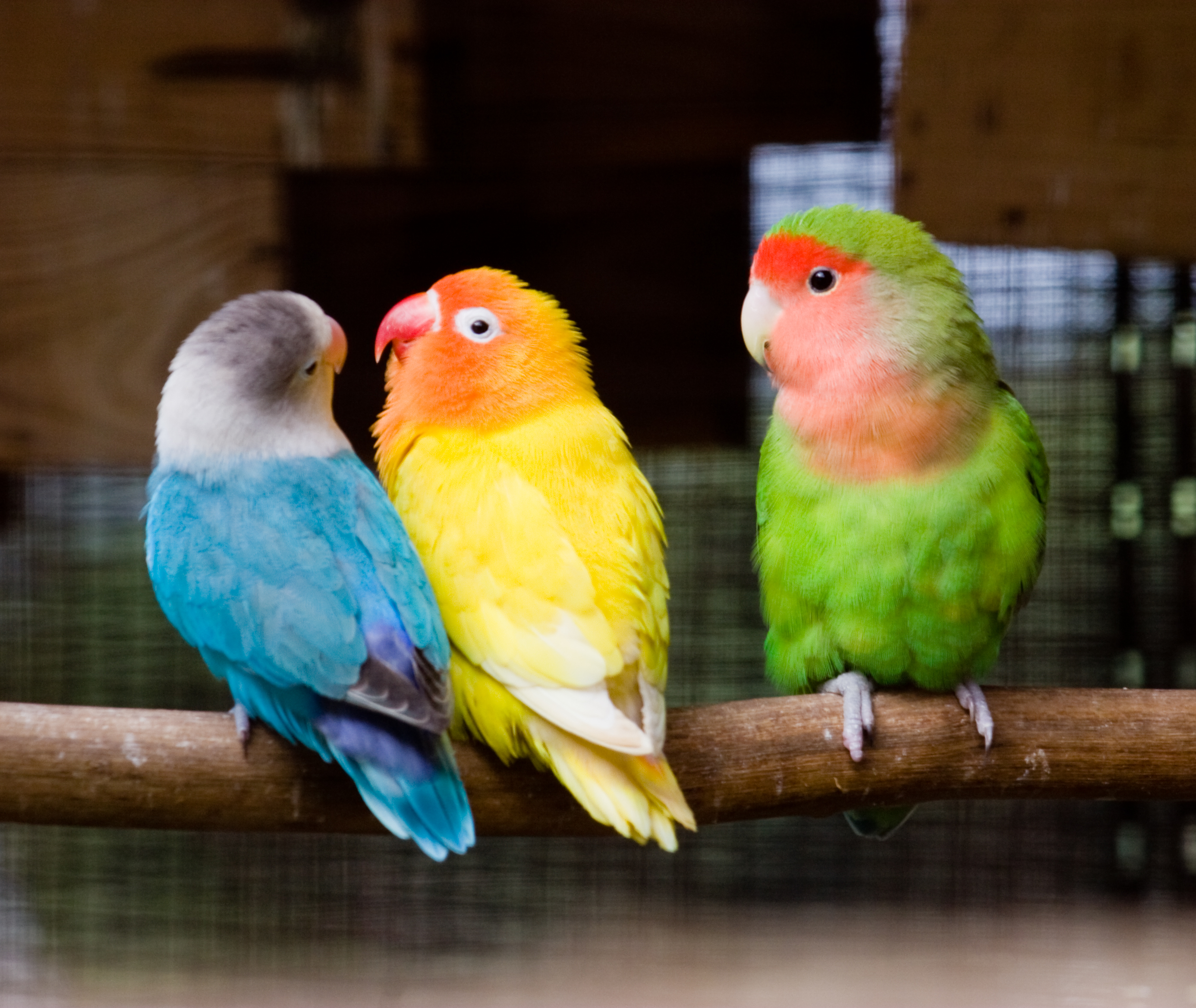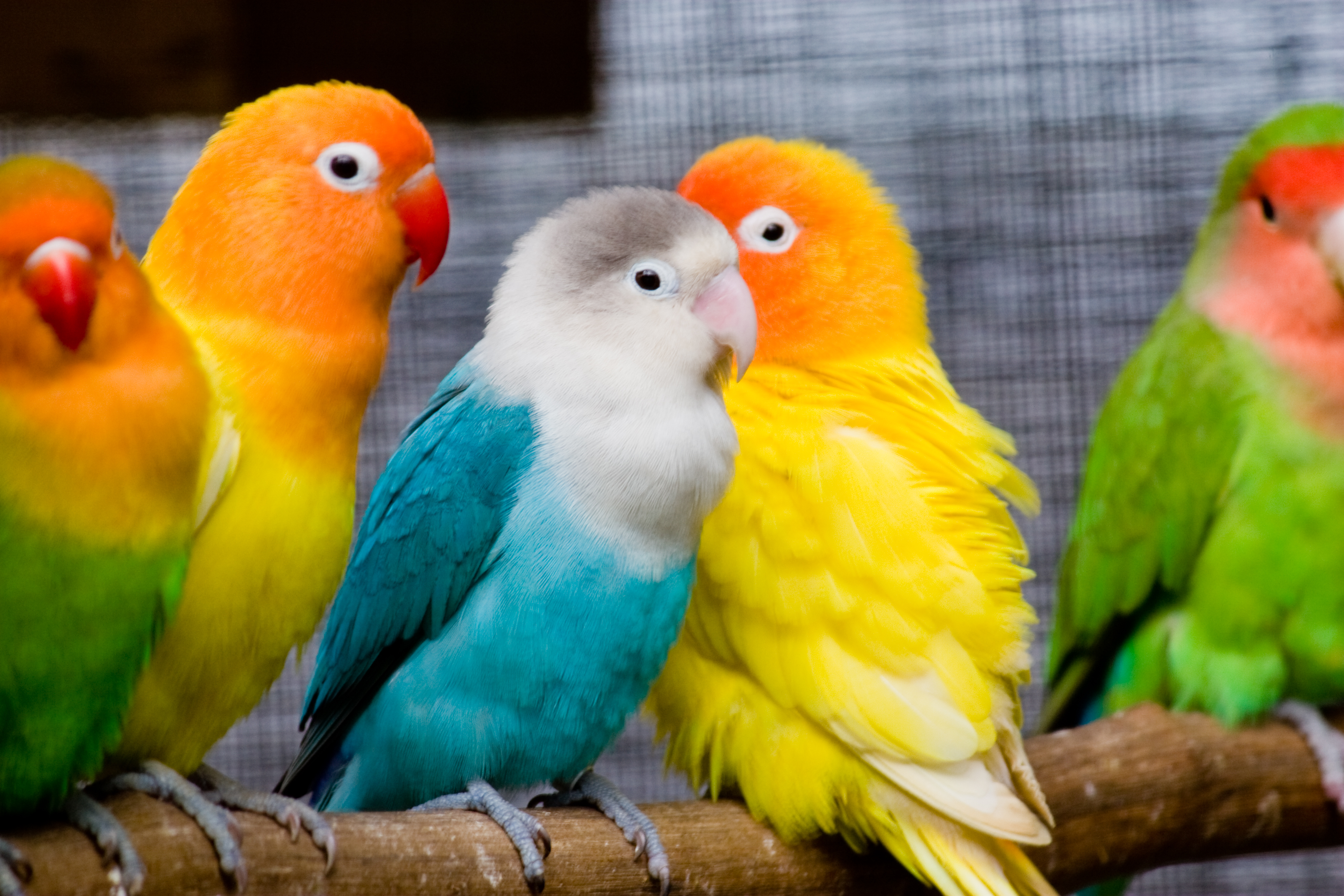What is the difference between male and female lovebirds?
Lovebirds are one of the types of birds that belong to the parrot family, and it is the smallest in this family, but it is unable to speak, and it is the most beloved species of the African parrot for more than 100 years, and it has nine species that differ in characteristics and traits, and lives for 20 years In homes, it is one of the most preferred types of birds for humans for breeding inside homes and apartments due to its small size, and it is widely spread in Africa and Madagascar, and it is the most traded bird in the world, and its population around the world is estimated between 290,000 to 1002,200 birds.
The male differs from the female bird in its composition and physical characteristics, and the differences between them can be known through the following:

- In terms of size, it is common for male lovebirds to have a larger size, but this is a wrong belief, as the male appears to be more spacious in the manner of his sitting and not his true size.
- In terms of head shape, the head shape of males in lovebirds is less rounded than the shape of the head of females.
- In terms of eye-ring In some but not all species of lovebirds, the female has a thicker eye-ring than the male's.
- In terms of the beak, the beak of the female lovebird appears larger and wider than the beak of the male.
- In terms of the width of the pelvis, the female's pelvic bones seem separate and wide, especially if she has laid eggs before. In the male, the bones are close together and there is no separation; That is, the pelvis appears narrow in the male.
- In terms of behaviour, males behave gentle and less aggressive than females, and in nature, the female takes care of the nest during the breeding period while the males work to bring food.
- In terms of color, the color cannot be considered significant and distinct between the sexes, as some types of lovebirds do not differ in the female from the male in terms of color, but in some species, such as lovebirds in Madagascar, the male has a gray head and neck while the female is completely green, and without Gray marks at all, and in a red-faced lovebird.
Males of this species have red faces, while females' faces tend to be more orange than red.
It is difficult to distinguish between male and female lovebirds, but it is possible to distinguish between them by many apparent physical and morphological characteristics, and these different characteristics are: size, head shape, eye ring, beak, pelvic width, behavior and color.
Frequently asked questions about lovebirds:
When do lovebirds lay eggs?
Female lovebirds lay eggs after ten days of mating with the male, and they usually lay eggs at night. .
When is the lovebird mating season?
Lovebirds begin the process of sexual maturity at about the age of one year. After the age of one year, they begin to mate and produce fertilized eggs, which will turn later, and after the female lies on them for about three weeks into small lovebirds, so that there is no specific time for the reproduction of lovebirds as they need to The male is next to the adult female to complete the mating process and produce the young, and the efficiency of the reproduction process increases during the dry season
Does a lovebird die when its partner dies or is it a rumor?
The lovebird does not die when its partner dies, but it grieves at his separation or death, because of the strong bonds that are built between the pair of lovebirds, so that it is noticed that they eat, drink and sleep next to each other, so the love bird feels sad when parting with his partner and needs time to overcome the stage of sadness this is.
How much do lovebirds cost?
There are nine different types of lovebirds, and the price of lovebirds varies between these types, and on average, the prices of lovebirds in general range from $75 to $200, for example, a peach-faced lovebird whose price ranges between $79.99 and $200, and a lovebird Fisher averages $99, and Lovebird Black Mask ranges from $80.99 to $87.99.
What causes the death of lovebirds?
The lovebird in the cage may always die in homes, due to lack of exposure to sunlight, which leads to a lack of vitamin D and the diseases that may accompany it, and it is also possible for lovebirds to die when collecting different birds of different ages with each other and the lack of hygiene in the place, Which causes fatal coccidiosis, and laziness in females may lead to their death, especially in the stage of laying eggs, as they are attached to the eggs and do not move until they die, and the egg remains stuck to it and cannot defecate, causing bacterial infection and this is called egg binding.
What is placed in the nest of lovebirds?
In nature, female lovebirds bring green grasses and moist nesting materials, which helps in the hatching process, and the young ones need moisture in the process of their growth, and in homes when intending to raise lovebirds, the responsible for these birds must provide the appropriate environment for the birds in terms of building the appropriate nest For it, when building the nest or buying it, it must be wide enough to allow the bird to move freely inside it, and it is preferable that it be square or rectangular so that the bird can hide in it, and toys can be placed inside the cage such as colored models, provided that these models are not wooden, and it is important to place the bowls Which contain water and food in the cage away from the bottom, and hygiene is a very basic requirement to maintain the health of birds.
Beginning lovebirds are divided into two platoons:
1. faction Fischer
2. faction roseicollis
I will provide a detailed explanation of his faction Fischer (and especially as they are currently doing my platoon reared only) and a brief explanation of his faction Rose where breeding Fischer not
different breeding Rose:
First: how to choose the appropriate birds Educational:
1. beginning of the preferred choice of small birds age (age ranges from two and a half to three months) to be raised from the beginning, this ensures the jam and hobbyist that birds are at the beginning of her life, and thus be aware of all the development during a life cycle, and must also choose the birds from a trusted source, and therefore so as to ensure the jam they are free from any disease and also ensures its origins, and always take into account when choosing a bird to be well, and with a vibrant and clear, and that is the bird sound and full plumage, this also follows up the bird activity and movement in the cage, especially in the period the first to bring it, as it should be to isolate AT birds show symptoms of any illnesses that away from other birds until no longer be infected with contagious diseases whereupon the transfer of infection to the rest of the birds.
2. After selecting birds and small good occasion for the purpose of nurturing is placed in Slake or a large cage and large so that they can move freely and the starting point, and start feeding in a way particularly good they are small people, food is for her at this stage is very important, in the sense that the foundation will continue Flying it later and throughout his life, given it represents good food at the beginning of importance for birds young age.
Second bird food love:
And supports good food for birds and general small especially on diversity, in the sense it is known that food is the key for lovebirds is grain (Vlars - Dniba - Bnickam - the core of sunflower) is taken into account when mixing all these pills to be ratios suitable out of all proportion the type to the other type, meaning that, for example, it is known that the pills Filars is one of the cereals high value food but not this what it means to be the main food for the birds, due to what can be caused from the dangers for the birds, since the pills Filars cause severe obesity of the bird after the time of use quantities, may eventually lead to what is known Ptlies jumper, a be many fat in the body of the bird, especially in the lower abdomen area, which impedes the female for egg laying, and this Malanradh for our chicken, of course.
So the jam that must be mixed with food during the work of Home for birds shall be quantities following order:
First bulk quantity of pills for Dniba then followed pills Abannickam (can be in the winter to be equal to the Dniba) and then immediately followed by pills Filars, that Filars be less than all the existing grain in the amalgam, and for pulp sunflower, although no preferential profile of him, but jam can put a small core of some of its sunflower pot as a kind of change in front of the bird.
In addition to the diet dry, a grain which has already been referred to, it must be on the jam that extends birds some meals soft, such as lettuce, watercress, alfalfa, carrots, radishes, all these vegetables represent good food and effective, it needs the bird, both small birds or large alike, and of course I am a Aaqsd that all previously vegetables once putting it in front of the bird, but I mean he is diversification in these types where they are once put lettuce and arugula time ... .. and so on.
In addition to the foregoing, there is an important element for the bird which is a protein, since these birds in nature feed on the type of worms, the duration necessary protein him, and of course, this type of food is not available to the breeders, but it is replaced by another from the food type and is boiled eggs and Almehroos and genitive Rusk crunched, and are mixed well and placed in a small pot in front of the bird, and this is a good protein for birds, especially during the spawning and feeding Alafarrak small as we shall see later.





0 Comments